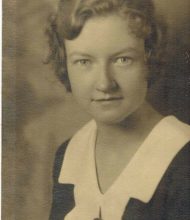
 On 19 May 2013, my mother died, four days after her hundredth birthday.
On 19 May 2013, my mother died, four days after her hundredth birthday.
She’d been living for weeks on ice chips and low-dose morphine, regularly leaving her body to walk and talk with my father, then returning to report to my brother at her bedside and to me via long-distance phone. No one knew when she would leave and not return, but everyone believed that her departure was imminent.
Five days before her centennial, however, she suddenly said to my brother, “It’s only a week away; maybe I can make it.” And she revived, sending the nursing-home staff into a frenzy of last-minute party planning. When the morning of her birthday dawned sunny and warm, they came to dress her for a convertible ride around the small town of Reinbeck, Iowa, and she said, “Hallelujah, I thought I’d never get out of this place alive.”
The convertible was a bright yellow muscle car with the top down, and the route had been planned so that town residents could come out on the curb to sing “happy birthday” to her at various stops along the way. It all worked like a charm, and she made the driver stop three times in addition, to listen to the birds singing and to watch squirrels run up and down the tree trunks. After a half-hour ride, they returned to her room, which had been transformed into a festival of balloons and cakes and flowers and visitors with cameras.
The next morning, she slipped into a coma and was gone three days later. And the morning following her death, I woke with the realization that there was no one left but me who knew the stories of her early life. In a rush to send something to my brother before her grandchildren and great-grandchildren gathered for her funeral, I wrote the following:
Some Things You May Not Know About the Young Kathryn Louise Truitt Ellenberger:
When she was four years old, the family doctor told her parents that she would not live to grow up and all they could do was make sure that her childhood was happy. After that, her father stopped drowning the barn cats’ new litters, and soon she had over thirty kitten playmates.
She rode her own pony to school, trying to keep up with her older brother Keith’s horse.
When she was eight, her father died and their farm was sold, and her mother’s parents built a second story on their house in town to make room for their daughter and her children. The house was full of books, and there were large flowerbeds, a vegetable garden, and fruit trees.
She was an avid tennis player. When she was thirteen, her mother became alarmed at the amount of time she was spending with older boys on the town’s tennis court, and sent her to work for the summer as a hired girl on a relative’s farm. Kathryn did not like working in the kitchen from dawn until the supper dishes were washed, followed by a pile of mending until 10 p.m.
Kathryn thought she might like to be an interior decorator, but everyone assumed she would become a country schoolteacher, following in the footsteps of her older sisters Mabel and Lucile. She did not do this. After high school graduation, Lucile gave her the money to go to business school in Des Moines.
When she graduated from business school, she was offered a job in the Des Moines Public Library system. She worked in the downtown library and lived in the Brown Hotel with several roommates.
One of her roommates, Bunny, wanted to take the civil-service exam and asked Kathryn to take it at the same time, as moral support. Within a few days, Kathryn received a telegram offering her a job in the Navy Building in Washington, DC. She immediately sent a telegram back, accepting the job. Only then did she tell family and friends, and soon she was boarding a train for the East Coast.
Her boyfriend Carl Ellenberger was classified 4-F because he had lost the thumb on his right hand in a corncob-crusher accident. Kathryn’s boss, an admiral, waived a few bureaucratic rules and soon Carl was in Naval Intelligence.
When Kathryn delivered certain materials to other government departments in DC, she was driven in a chauffeured limousine and carried a revolver in her purse.
Kathryn was well-dressed in wartime Washington because she cut out magazine photos of the clothes she wanted to wear, and mailed them to her mother in Iowa. Her mother designed the pattern, found the fabric, sewed the outfit, and mailed it back to her.
Carl Ellenberger had first asked Kathryn to marry him when they were both seventeen. In 1942, when they were both twenty-nine, he told her it was the last time he’d ask and she believed him. She said yes.
The specifics of what Carl and Kathryn were doing for the Navy during World War II are known only to them. Kathryn and my partner had a tacit telephone understanding: she knew that he knew that she knew that … But I remain clue-less.
Postscript, October 2013
Despite over sixty years of conversation with my mother, it’s not only her wartime activities I’m in the dark about. We had a meeting of the minds on two things: the allure of good food and the beauty of Chopin’s waltz in C# minor, op. 64, no. 2, which she liked me to play for her. With most everything else – politics, religion, the nature of reality – we tended to be stationed on opposite sides of the barricades.
I couldn’t fathom what drove my mother, and she had the same difficulty with me. But we kept on talking. And — judging by the evidence of my dreams — the conversation, in some mysterious way, continues.
Authored by Harriet Ann Ellenberger.

For Kathryn Louise Truitt Ellenberger
New Brunswick, Canada
For my loving mother.
Harriet Ellenberger








